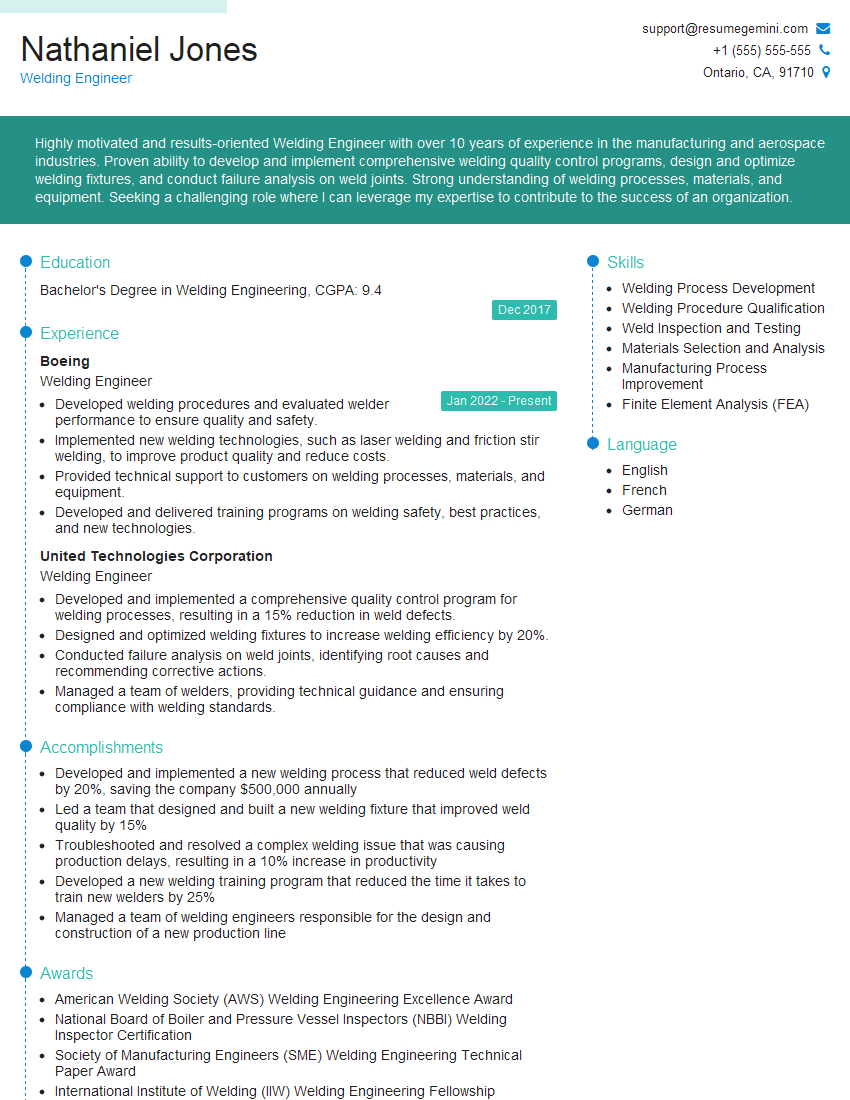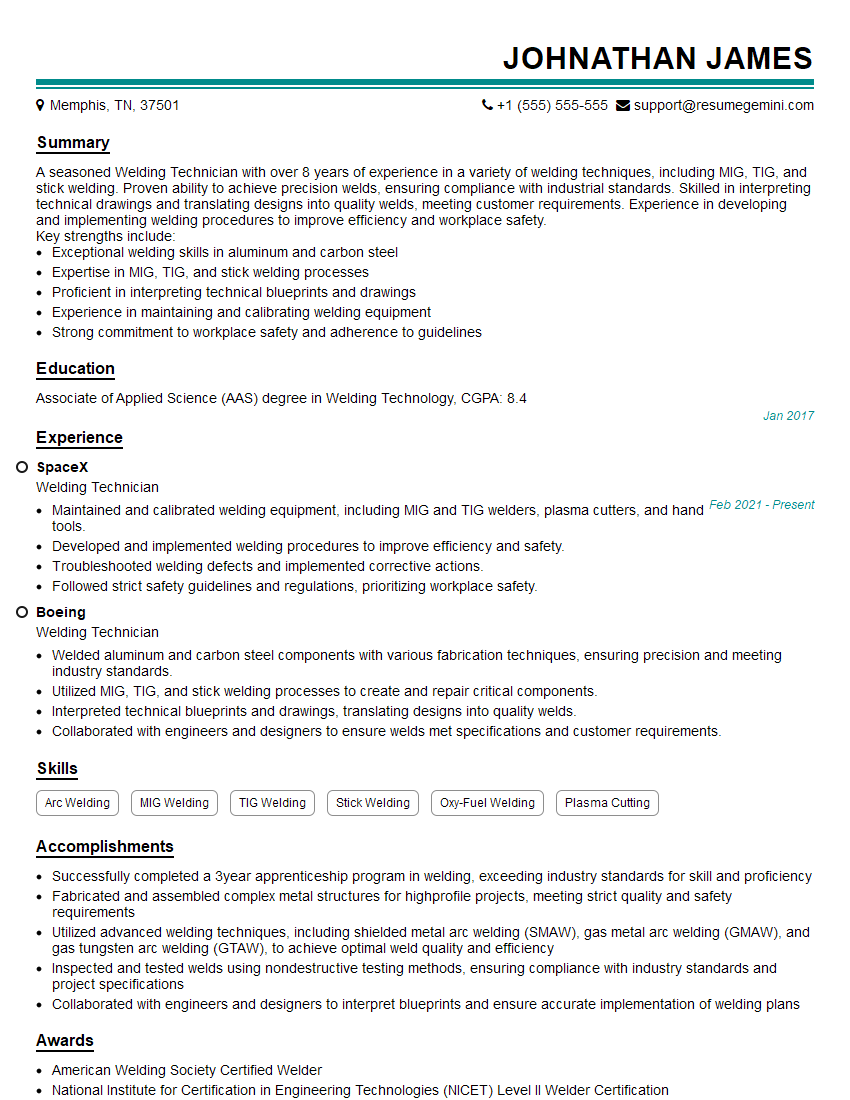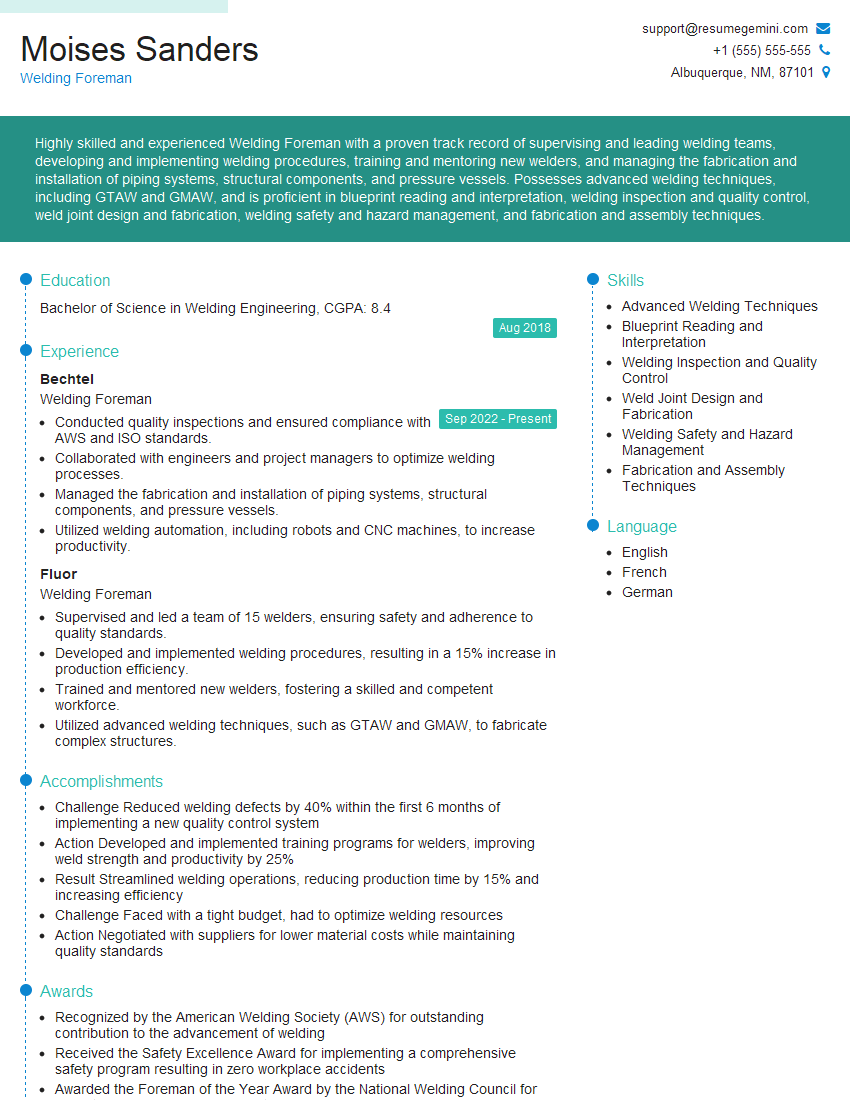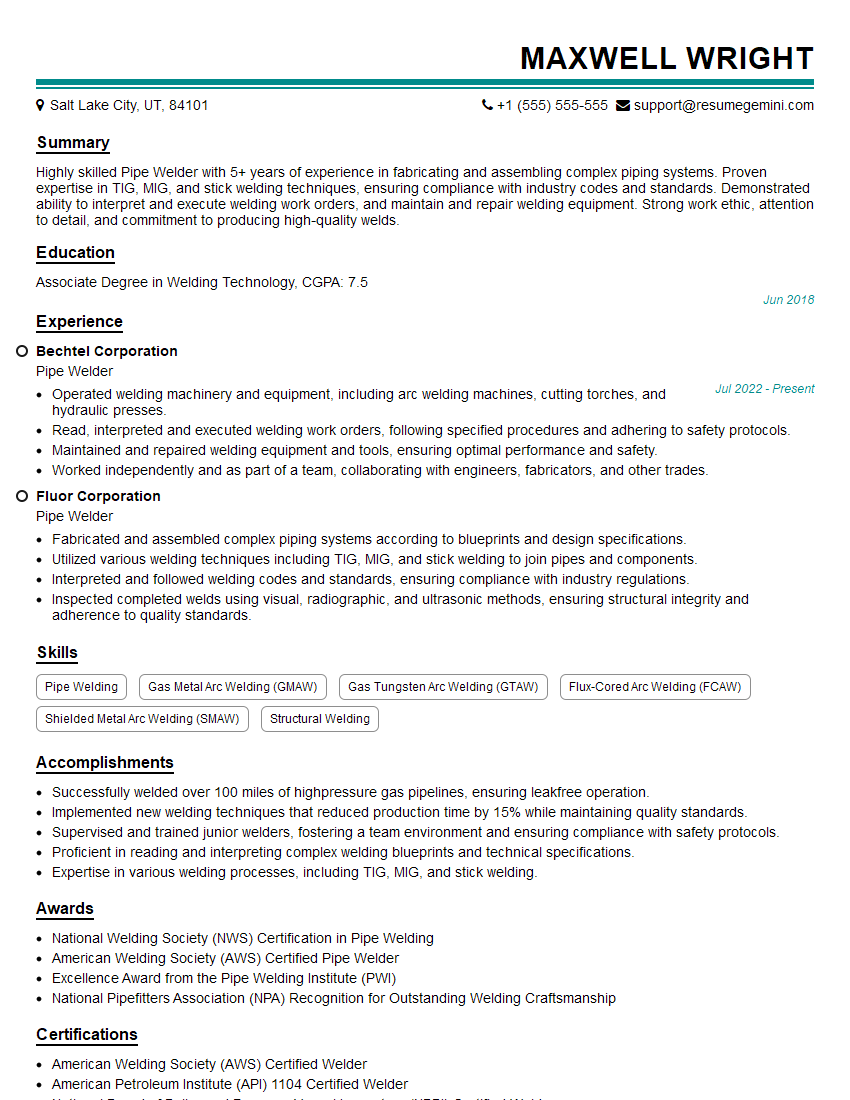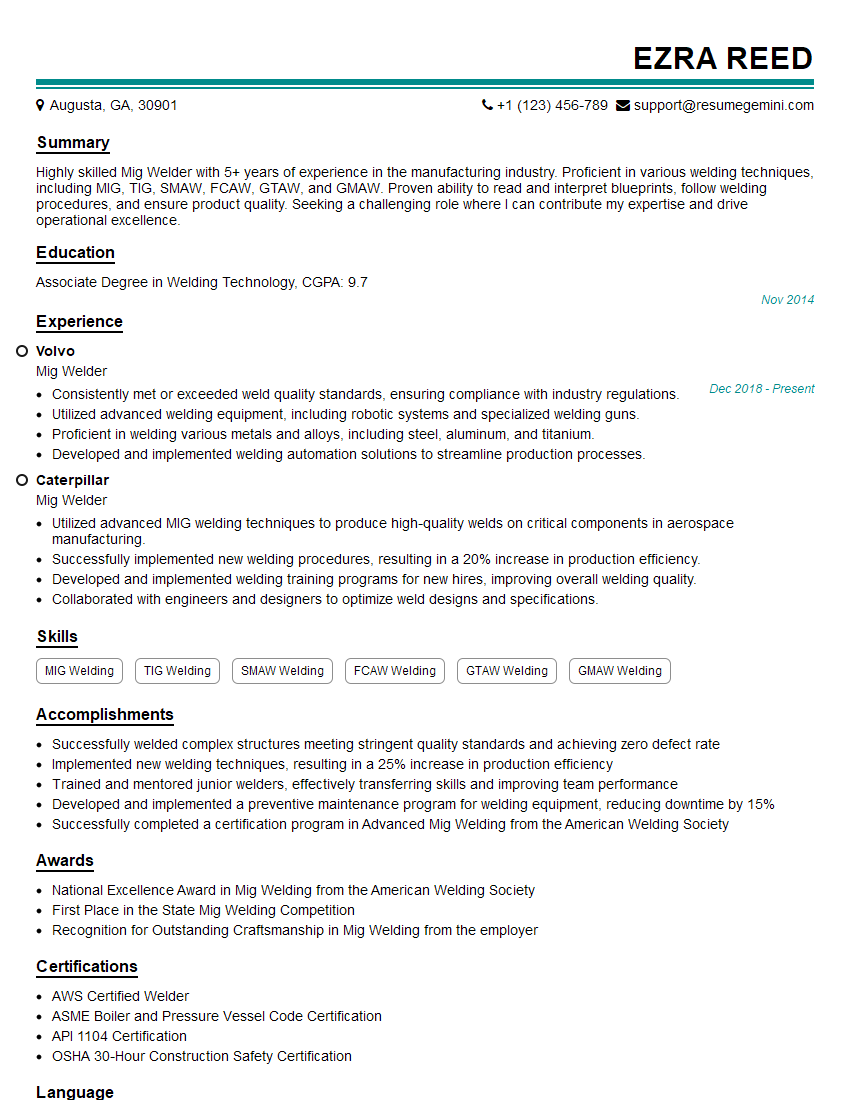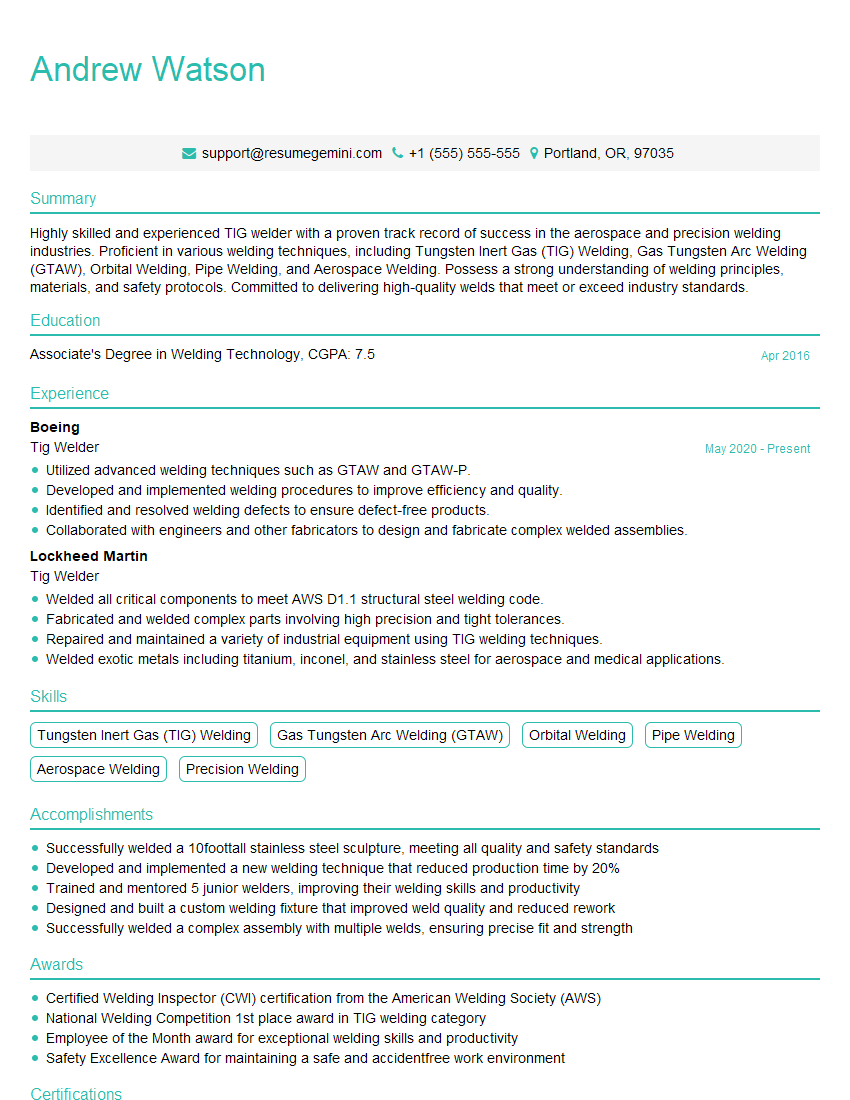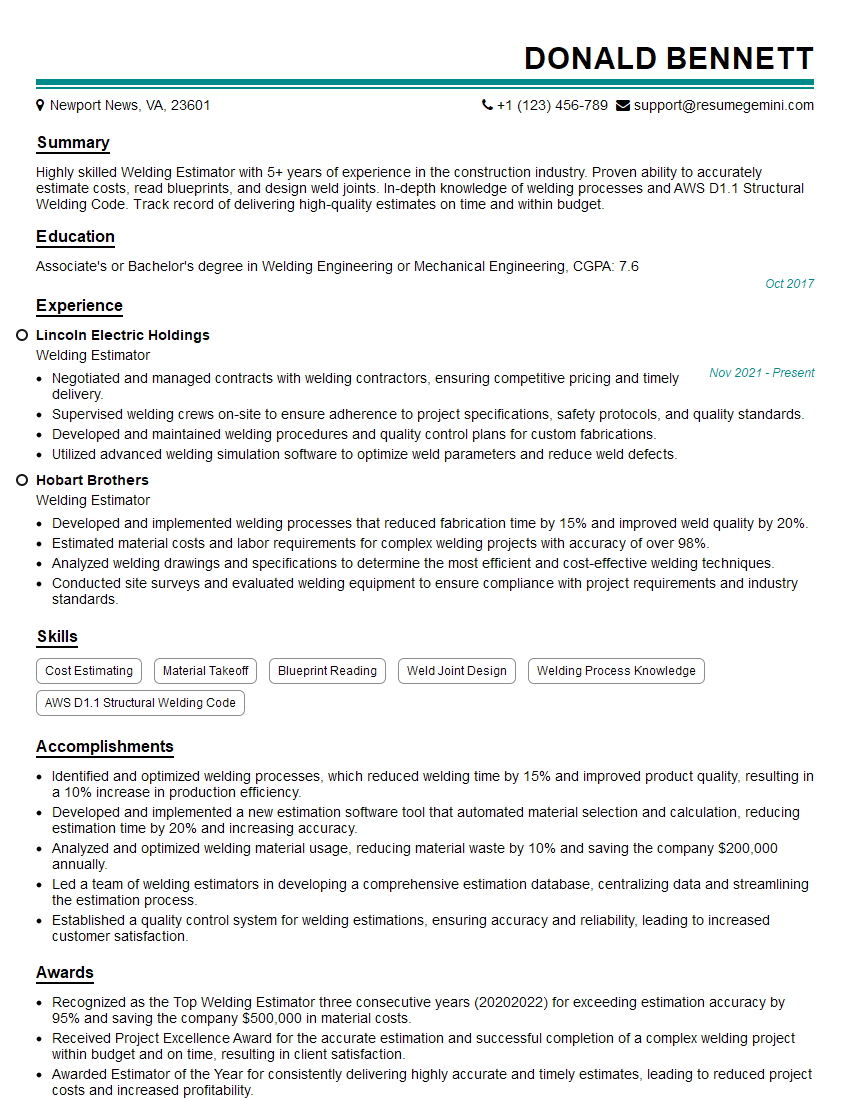Unlock your full potential by mastering the most common Brazing and Welding Techniques interview questions. This blog offers a deep dive into the critical topics, ensuring you’re not only prepared to answer but to excel. With these insights, you’ll approach your interview with clarity and confidence.
Questions Asked in Brazing and Welding Techniques Interview
Q 1. Explain the difference between brazing and welding.
Brazing and welding are both joining processes that use heat to fuse materials, but they differ significantly in the melting points involved and the nature of the joint. In welding, the base materials are melted and fused together, forming a homogenous joint. Think of it like melting two ice cubes together and letting them refreeze as one. The filler material, if used, also melts and blends completely with the base metals. Brazing, on the other hand, uses a filler metal with a lower melting point than the base materials. The filler metal flows into the joint by capillary action, creating a strong bond, but the base metals themselves don’t melt. Imagine using hot glue to join two pieces of wood; the glue melts and fills the gap, but the wood remains solid.
This difference leads to key distinctions in applications. Welding is suitable for applications requiring high strength and full fusion, like structural steel beams in buildings. Brazing is preferred for joining materials with different melting points or where localized heat is desirable to avoid damaging sensitive components, such as in electronic circuits or heat exchangers.
Q 2. What are the different types of welding processes?
There’s a wide array of welding processes, each with its own advantages and disadvantages. They can be broadly categorized based on the type of heat source used and the shielding method employed. Here are some key examples:
- Shielded Metal Arc Welding (SMAW): Uses a consumable electrode coated with flux to protect the weld from atmospheric contamination. It’s versatile, relatively inexpensive, and portable, making it common in construction and repair.
- Gas Metal Arc Welding (GMAW): Also known as MIG welding, it uses a continuous wire electrode and a shielding gas (usually CO2 or argon) to protect the weld. It’s faster and produces cleaner welds than SMAW.
- Gas Tungsten Arc Welding (GTAW): Known as TIG welding, it uses a non-consumable tungsten electrode and a shielding gas. This technique offers excellent control and produces high-quality welds, often used for critical applications involving thin materials or stainless steel.
- Resistance Welding (RW): Uses electrical resistance to generate heat and fuse the materials. Spot welding, seam welding, and projection welding are common resistance welding techniques.
- Laser Beam Welding (LBW): Employs a high-powered laser beam to melt and fuse the base materials, leading to precise and deep welds, often used in the automotive industry.
Choosing the right welding process depends on factors like material thickness, weld joint design, required weld quality, and cost considerations.
Q 3. Describe the characteristics of a good weld.
A good weld exhibits several key characteristics:
- Complete Penetration: The weld should fully fuse the base materials, ensuring complete joint integrity. Incomplete penetration leads to weakened joints.
- Proper Fusion: There should be a smooth transition between the weld metal and the base material, free from discontinuities. Poor fusion can result in cracks or porosity.
- Good Profile: The weld bead should have a smooth, consistent profile, free from excessive undercut or reinforcement. An uneven profile indicates inconsistent welding parameters.
- Soundness: A good weld is free from internal defects like cracks, porosity (gas bubbles), or inclusions (foreign materials). These defects compromise the strength and reliability of the weld.
- Correct Size: The weld should be the appropriate size and shape to meet design requirements. Oversized or undersized welds can be problematic.
Inspecting for these characteristics is essential to ensure the weld’s structural integrity and reliability. Visual inspection, radiography, and ultrasonic testing are common methods used for weld quality assessment.
Q 4. What are the safety precautions necessary when welding?
Welding presents several significant safety hazards, so proper precautions are critical. These include:
- Eye and Face Protection: Always wear appropriate safety glasses or a welding helmet with a shade appropriate for the process being used to protect against intense UV and infrared radiation.
- Respiratory Protection: Welding fumes can be toxic, so proper ventilation and respiratory protection (such as a respirator) are essential.
- Skin Protection: Welding sparks and spatter can cause burns, so protective clothing like gloves, a welding jacket, and flame-resistant pants should be worn.
- Fire Prevention: Keep flammable materials away from the welding area. Have a fire extinguisher readily available.
- Electrical Safety: Proper grounding and insulation are crucial when working with electrical welding equipment.
- Post-weld cleaning: Properly dispose of the welding slag and other byproducts, following all environmental regulations.
Regular training and adherence to safety protocols are vital for preventing accidents and ensuring the safety of welders and those around them.
Q 5. How do you select the appropriate filler metal for a specific application?
Filler metal selection is crucial for achieving a strong and reliable weld. The choice depends on several factors:
- Base Material: The filler metal must be compatible with the base materials being joined. For example, you wouldn’t use a steel filler metal on aluminum.
- Weld Joint Design: The type of joint (butt, fillet, lap, etc.) influences the filler metal selection, as different joints require different weld metal properties.
- Mechanical Properties: The required mechanical properties (tensile strength, ductility, hardness, etc.) of the weld dictate the choice of filler metal to match the needs of the application.
- Operating Environment: The operating environment (temperature, corrosive conditions, etc.) influences the selection of filler metal for enhanced durability and corrosion resistance.
- Welding Process: The welding process being used also affects the selection of filler metal. For instance, the filler metal for GMAW is usually a solid wire, while for SMAW it’s a coated rod.
Consult manufacturer’s data sheets and welding codes for guidance on selecting the appropriate filler metal. A common example is selecting a stainless steel filler metal for welding stainless steel components to maintain corrosion resistance.
Q 6. Explain the importance of pre- and post-weld heat treatments.
Pre- and post-weld heat treatments are often crucial for optimizing weld properties and mitigating potential issues.
Pre-weld heat treatment can improve weldability by reducing internal stresses, refining the grain structure, and improving the ductility of the base material. This is especially important with high-strength steels or materials prone to cracking during welding. For instance, preheating can prevent the formation of hard, brittle zones in the heat-affected zone (HAZ) of the weld.
Post-weld heat treatment (PWHT) is used to relieve residual stresses introduced during welding, which can lead to cracking or distortion. It can also improve the toughness and ductility of the weld and the heat-affected zone. Stress-relieving PWHT is a common practice after welding large, thick components to reduce the risk of cracking. Sometimes, PWHT is used to optimize the microstructure for specific applications, like achieving a particular hardness level or improving corrosion resistance.
The specific parameters of pre- and post-weld heat treatments (temperature, time, and cooling rate) depend on the material, welding process, and design requirements. Following established procedures and codes is essential to ensure the effectiveness and safety of these treatments.
Q 7. What are common weld defects and how are they identified?
Common weld defects can significantly impact the structural integrity and performance of welded joints. These can be classified into several categories:
- Cracks: These are discontinuities that propagate through the weld metal or HAZ. They can be caused by residual stresses, hydrogen embrittlement, or poor weldability. Cracks often result in sudden failure under load.
- Porosity: Gas bubbles trapped within the weld metal weaken the weld and reduce its fatigue resistance. Porosity can result from improper shielding, contamination, or moisture in the base material or filler metal.
- Inclusions: Foreign materials trapped within the weld metal, such as slag or tungsten inclusions (from TIG welding), can create stress concentrations and weaken the joint. Proper cleaning and shielding techniques help prevent this.
- Undercuts: A groove melted into the base material at the edge of the weld, resulting from excessive heat input or improper welding technique. Undercuts reduce the weld’s effective cross-sectional area and strength.
- Lack of Fusion: Incomplete bonding between the weld metal and base material, creating a weak point in the joint. It’s caused by improper heat input or cleaning of the surfaces.
- Lack of Penetration: The weld metal doesn’t completely fuse through the entire thickness of the joint, leaving an incomplete joint.
Visual inspection, radiographic testing (RT), ultrasonic testing (UT), and dye penetrant testing (PT) are some of the methods used to identify and assess the severity of weld defects.
Q 8. How do you interpret welding symbols?
Welding symbols are a standardized shorthand notation used on engineering drawings to communicate all the necessary information about a weld. Think of them as a visual instruction manual for welders. They provide details on the type of weld, its size, length, location, and other critical parameters. Understanding these symbols is crucial for ensuring that the weld is executed correctly and meets the required specifications.
A typical welding symbol includes a reference line, an arrow indicating the weld location, a basic weld symbol representing the weld type, and various other supplementary symbols that provide further details such as dimensions, weld process, and surface finish. For example, a symbol might show a continuous fillet weld, specifying its size (leg length), location on the joint, and whether it’s on one or both sides.
- Reference Line: The horizontal line from which other symbols are referenced.
- Arrow: Points to the location of the weld on the part.
- Basic Weld Symbol: Indicates the type of weld (e.g., fillet, groove, spot).
- Dimension: Specifies the size of the weld.
- Process Symbol: Indicates the welding process to be used (e.g., GMAW, GTAW).
Mastering welding symbols involves practice and familiarity with the relevant standards (like AWS D1.1 for structural welding). Each symbol represents a specific weld configuration, and misinterpreting one can lead to critical errors.
Q 9. Explain the concept of weld penetration and its importance.
Weld penetration refers to the depth to which the weld metal fuses into the base metal. It’s a crucial aspect of weld quality because inadequate penetration can lead to weaknesses and failures in the welded joint. Imagine trying to connect two pieces of wood with glue – if the glue doesn’t penetrate deep enough, the connection will be weak. Similarly, insufficient weld penetration leaves a gap between the base materials, compromising the structural integrity of the weld.
Sufficient penetration ensures a strong, reliable bond between the base materials. The required level of penetration depends on the application’s specific requirements and is often detailed in engineering drawings or welding procedure specifications (WPS). Factors influencing penetration include the welding process, current, voltage, travel speed, and the type of filler metal used. For example, in a butt weld, complete penetration is often required to ensure a sound joint.
Measuring penetration can be done through visual inspection, radiographic testing (RT), or ultrasonic testing (UT). Lack of penetration is a common weld defect detected during quality inspections and can necessitate rework or rejection of the component.
Q 10. What are the different types of brazing alloys?
Brazing alloys are filler metals with lower melting points than the base metals being joined. They are selected based on the base metals, the application’s required strength and temperature resistance, and other factors like corrosion resistance. Common brazing alloys are categorized by their base metal composition.
- Copper-based alloys: These are widely used, offering good strength and ductility. Examples include copper-zinc (brass) and copper-phosphorus alloys.
- Silver-based alloys: Known for their high strength, corrosion resistance, and excellent flow characteristics. They’re often used for high-performance applications.
- Nickel-based alloys: Provide good high-temperature strength and corrosion resistance, suitable for applications in harsh environments.
- Aluminum-based alloys: Often used for joining aluminum and aluminum alloys, offering good corrosion resistance.
The selection of a brazing alloy is a critical decision in the brazing process. The alloy must be compatible with the base metals and possess the necessary properties for the intended application. An incorrect choice can lead to weak joints or failure.
Q 11. Describe the brazing process, including flux application and temperature control.
Brazing involves joining base metals using a filler metal that melts at a temperature below the melting point of the base metals. The process is usually done in a controlled environment, possibly using a furnace or torch. The key stages are:
- Preparation: Clean the surfaces to be joined thoroughly to ensure proper wetting by the filler metal. This typically involves mechanical cleaning (e.g., brushing, grinding) and chemical cleaning (e.g., using solvents or degreasers).
- Flux application: Flux is essential to prevent oxidation during the brazing process. It cleans the surfaces and helps the filler metal flow smoothly into the joint. Fluxes are available in paste, liquid, or powder form, and the selection depends on the base metals and the brazing alloy used.
- Heating: Heat the assembly to the brazing temperature. Precise temperature control is crucial to avoid overheating the base metals, which can cause distortion or damage. Various heating methods are used, including torch brazing, furnace brazing, and induction brazing.
- Filler metal application: The filler metal is introduced into the joint as the assembly reaches the brazing temperature. Capillary action draws the molten filler metal into the joint, forming a strong bond between the base metals.
- Cooling: Allow the assembly to cool slowly to prevent cracking or distortion. Cooling rates are often controlled to ensure optimum joint properties.
Temperature control is vital. Overheating can melt the base metals, while underheating may not allow the filler metal to flow properly, resulting in a poor joint. Proper selection of flux and filler metal is crucial for achieving a successful brazing operation.
Q 12. How do you ensure the proper fit-up of parts before brazing or welding?
Proper fit-up is fundamental to both brazing and welding. It refers to the precision with which parts are positioned and aligned before joining. Poor fit-up leads to inconsistent welds or braze joints, potentially weakening the final product. Imagine trying to glue two pieces of wood together that don’t align—the bond will be weak and uneven.
Ensuring proper fit-up involves:
- Accurate dimensional checks: Verify dimensions and tolerances to ensure parts meet the required specifications.
- Clean surfaces: Remove any contaminants like dirt, grease, or oxides that may hinder the bonding process.
- Precise alignment: Use jigs, fixtures, and clamps to ensure accurate alignment of the parts, minimizing gaps or overlaps.
- Joint preparation: Prepare the joint surfaces appropriately. This might involve machining, grinding, or other surface treatments depending on the joint design and the materials being joined.
- Pre-assembly checks: Carry out a thorough visual inspection before proceeding with brazing or welding to identify and rectify any fit-up problems.
Achieving good fit-up requires meticulous attention to detail, appropriate tooling, and a good understanding of the materials and joining process.
Q 13. What are the limitations of brazing compared to welding?
Brazing and welding, while both joining processes, have key differences that determine their suitability for different applications. Brazing generally offers lower strength joints than welding, as it doesn’t involve complete melting of the base metals. The bond is formed through capillary action, pulling the molten filler metal into the joint.
- Joint Strength: Welding typically produces stronger joints due to the melting and fusion of the base metals, resulting in a more homogeneous structure.
- Heat Affected Zone (HAZ): Welding creates a larger HAZ, which can alter the material properties in the area surrounding the weld. Brazing’s lower heat input results in a smaller HAZ, minimizing such effects.
- Base Metal Melting: Brazing does not melt the base metal; welding does (at least partially).
- Joint Appearance: Welding often leaves a more pronounced weld bead, while brazed joints usually have a smoother, less visible joint.
- Applications: Welding is suitable for applications requiring high strength and structural integrity, while brazing is advantageous for joining dissimilar metals or applications where localized heating is critical.
For instance, welding is ideal for structural steel, while brazing might be chosen for joining heat exchangers to avoid weakening the base metal through extensive heating.
Q 14. What is the difference between GMAW and GTAW welding processes?
GMAW (Gas Metal Arc Welding) and GTAW (Gas Tungsten Arc Welding) are both arc welding processes, but they differ significantly in their techniques and applications.
- GMAW (MIG): Uses a consumable electrode wire, fed continuously into the weld pool. A shielding gas (usually CO2 or a mix of Argon and CO2) protects the weld from atmospheric contamination. GMAW is faster and generally more productive than GTAW, making it suitable for mass production applications. It’s commonly used for joining ferrous and non-ferrous metals.
- GTAW (TIG): Employs a non-consumable tungsten electrode. A separate filler metal rod may be added to the weld pool as needed. A shielding gas (typically Argon or a mixture of Argon and Helium) is also used. GTAW is known for its precise control and ability to produce high-quality welds, particularly for thin materials and critical applications. It’s often preferred for specialized work requiring clean, aesthetically pleasing welds.
In essence, GMAW is faster and more efficient for mass production, while GTAW offers better control and quality for precise and intricate work. The choice between these processes depends on the specific application requirements, material properties, and desired weld quality.
Q 15. Explain the principle of SMAW welding.
SMAW, or Shielded Metal Arc Welding, is a manual arc welding process where an electric arc is struck between a consumable electrode and the workpiece. The electrode is coated with a flux that protects the weld pool from atmospheric contamination (like oxygen and nitrogen), provides shielding gas, and adds alloying elements to the weld metal. Think of it like a tiny, controlled lightning strike, but with a protective layer to ensure a clean, strong weld.
The process works by applying a current to the electrode, creating an arc that melts both the electrode and the base metal. The molten metal is then deposited in the joint, forming the weld. As the electrode melts, the flux coating disintegrates, producing shielding gases (CO2, CO) and slag. This slag protects the weld from the atmosphere and floats to the top as the weld cools, solidifying. It’s then removed after the weld is complete. The process requires skill to maintain a consistent arc length and move the electrode smoothly to create a sound weld.
Career Expert Tips:
- Ace those interviews! Prepare effectively by reviewing the Top 50 Most Common Interview Questions on ResumeGemini.
- Navigate your job search with confidence! Explore a wide range of Career Tips on ResumeGemini. Learn about common challenges and recommendations to overcome them.
- Craft the perfect resume! Master the Art of Resume Writing with ResumeGemini’s guide. Showcase your unique qualifications and achievements effectively.
- Don’t miss out on holiday savings! Build your dream resume with ResumeGemini’s ATS optimized templates.
Q 16. What are the advantages and disadvantages of different welding power sources?
Welding power sources vary widely, each with its own set of advantages and disadvantages. Let’s consider Constant Current (CC) and Constant Voltage (CV) sources.
- Constant Current (CC): CC power sources maintain a relatively constant current regardless of arc length fluctuations. This is ideal for SMAW because it provides a more stable arc, making it easier for the welder to control. Advantage: Better arc stability, easier to learn. Disadvantage: Can be less efficient, higher risk of electrode sticking.
- Constant Voltage (CV): CV power sources maintain a constant voltage, with the current varying depending on the arc length. This is often used with GMAW (Gas Metal Arc Welding) and other processes where a consistent feed rate is crucial. Advantage: Greater versatility, suitable for high-speed welding. Disadvantage: More sensitive to arc length changes, requires more skill to master.
Additionally, we have different types of power sources based on the technology used (e.g., transformer-based, inverter-based, rectifier-based). Inverter-based sources are becoming increasingly popular due to their lighter weight, better efficiency, and control capabilities.
Q 17. Describe your experience with different joint designs.
My experience encompasses a wide range of joint designs, including butt joints (square, bevel, V, U, and double-V), lap joints, tee joints, corner joints, and edge joints. The choice of joint design depends on factors such as material thickness, joint access, weld strength requirements, and the welding process used. For instance, a double-V butt joint is often preferred for thicker materials because it allows for better penetration and minimizes distortion.
I’ve worked with various joint preparations, including machining, grinding, and the use of backing strips or shims to ensure proper fit-up and weld quality. I understand the importance of proper joint design for maximizing strength and minimizing stress concentrations. For example, I once had to design a complex tee joint for a pressure vessel application where we used a combination of fillet welds and groove welds to achieve optimal strength and prevent leakage.
Q 18. How do you troubleshoot common welding problems?
Troubleshooting welding problems often requires a systematic approach. I typically start by identifying the visible defect – is it porosity, cracking, lack of fusion, undercut, etc.? Then I systematically examine possible causes.
- Porosity: Often caused by moisture in the electrode, poor shielding gas coverage, or insufficient preheating.
- Cracking: Could be due to high heat input, rapid cooling, improper preheat/post-heat treatment, or hydrogen embrittlement.
- Lack of Fusion: Typically indicates insufficient heat input or improper joint preparation.
- Undercut: Often caused by excessive current, incorrect electrode angle, or too fast travel speed.
Addressing these issues might involve adjusting the welding parameters (current, voltage, travel speed), correcting joint preparation, ensuring proper electrode storage and handling, or changing welding techniques. I always document my findings and adjustments during troubleshooting, ensuring consistent improvement in weld quality.
Q 19. What types of non-destructive testing (NDT) methods are used to inspect welds?
Non-destructive testing (NDT) is crucial for ensuring weld integrity. Common methods used to inspect welds include:
- Visual Inspection (VT): The simplest method, used to detect surface imperfections.
- Radiographic Testing (RT): Uses X-rays or gamma rays to detect internal flaws like cracks, porosity, and lack of fusion.
- Ultrasonic Testing (UT): Employs high-frequency sound waves to detect internal flaws and measure weld thickness.
- Magnetic Particle Testing (MT): Used to detect surface and near-surface flaws in ferromagnetic materials.
- Dye Penetrant Testing (PT): Detects surface-breaking flaws by using a dye that penetrates cracks and is then drawn out to reveal the defect.
The choice of NDT method depends on the material, weld type, and the specific requirements of the application. I’m experienced in interpreting the results of these tests and using them to make informed decisions about weld acceptance or rejection.
Q 20. Explain your experience with different welding positions (e.g., 1G, 2G, 3G, 4G).
Welding positions refer to the orientation of the weld joint relative to the welder’s position. The most common positions are defined by the Welding Procedure Specification (WPS).
- 1G (Flat): Welding on a horizontal surface – the easiest position.
- 2G (Horizontal): Welding on a vertical surface with the weld bead facing upwards – requires more skill to control the molten metal.
- 3G (Vertical): Welding on a vertical surface with the weld bead facing downwards – more challenging due to gravity affecting the weld pool.
- 4G (Overhead): Welding above the welder’s head – the most difficult position, requiring high skill and precision.
My experience includes extensive practice in all four positions, ensuring consistent weld quality regardless of the joint orientation. I’ve handled challenging projects where 3G and 4G welding were necessary, demonstrating my capability to adapt my technique based on the position requirements.
Q 21. How do you maintain and care for welding equipment?
Maintaining welding equipment is vital for safety and ensuring high-quality welds. My routine includes:
- Regular Cleaning: Keeping the equipment free from spatter, slag, and debris. This is especially important for the welding gun, torch, and electrode holders.
- Cable Inspection: Checking cables for damage, wear, and proper insulation. Damaged cables pose significant safety risks.
- Gas Cylinder Inspection: Ensuring proper storage and handling of gas cylinders, checking pressure gauges, and using correct regulators.
- Equipment Calibration: Regularly calibrating the welding machine to maintain consistent performance. This involves checking voltage, current, and other parameters.
- Preventive Maintenance: Following manufacturer’s guidelines for routine maintenance, including lubrication and replacement of worn parts.
I emphasize safety during maintenance, always disconnecting the power source before performing any work. I’m proactive in identifying potential problems and addressing them before they cause downtime or safety hazards. A well-maintained welding machine translates directly into higher quality welds and a safer working environment.
Q 22. Describe your experience with robotic welding systems.
My experience with robotic welding systems spans over eight years, encompassing programming, operation, and maintenance of various models, including Fanuc and ABB systems. I’m proficient in designing and implementing robotic welding programs for complex geometries, utilizing offline programming software such as RoboDK. This includes creating weld paths, managing tool changes, and optimizing cycle times for maximum efficiency. I’ve worked on projects requiring high precision and repeatability, such as automotive parts and aerospace components, where robotic welding is crucial for consistent quality. A recent project involved integrating a collaborative robot (cobot) into our production line, significantly reducing human intervention in repetitive tasks while improving safety. I’m also familiar with troubleshooting robotic welding issues, from sensor malfunctions to programming errors, ensuring minimal downtime.
Q 23. What is your experience with welding different materials (e.g., steel, aluminum, stainless steel)?
I have extensive experience welding a wide range of materials, including mild steel, aluminum, stainless steel, and various alloys. Each material presents unique challenges requiring different techniques and parameters. For instance, welding aluminum requires specific procedures to prevent porosity due to its high affinity for oxygen. This involves using appropriate filler metals, such as aluminum wire with a suitable flux core, and employing techniques like pulsed MIG welding to control heat input and minimize distortion. Stainless steel welding demands careful control of heat to avoid sensitization and cracking, often utilizing GTAW (Gas Tungsten Arc Welding) for its superior control and ability to produce high-quality welds. Mild steel welding is more forgiving and can be accomplished using various methods such as SMAW (Shielded Metal Arc Welding), GMAW (Gas Metal Arc Welding), and FCAW (Flux Cored Arc Welding), depending on the application and desired weld quality.
Q 24. Explain your familiarity with different welding codes and standards (e.g., AWS D1.1).
My understanding of welding codes and standards is comprehensive, encompassing AWS D1.1 (Structural Welding Code – Steel), ASME Section IX (Welding and Brazing Qualifications), and various other industry-specific standards. I’m proficient in interpreting code requirements, ensuring compliance in all aspects of welding procedures, from welder qualification to material selection and inspection. AWS D1.1, for example, dictates specific requirements for weld joint design, welding procedures, and inspection criteria for structural steel. I understand the importance of these standards for safety and structural integrity. I’ve used these codes extensively in project planning and execution, ensuring the welds produced meet the required strength, toughness, and durability. My familiarity with these standards extends to the creation and implementation of Welding Procedure Specifications (WPS) and Procedure Qualification Records (PQR).
Q 25. How do you ensure quality control in a welding operation?
Quality control in welding is paramount. My approach involves a multi-faceted strategy that begins even before welding starts. This includes meticulous planning, ensuring correct material selection, and verifying that the WPS is appropriate for the specific application. During welding, I maintain consistent parameters and visual inspection to identify and rectify defects immediately. Post-weld inspection involves various non-destructive testing (NDT) methods, including visual inspection (VT), radiographic testing (RT), ultrasonic testing (UT), and dye penetrant testing (PT). These methods allow for detection of internal and surface flaws such as porosity, cracks, and incomplete fusion. Detailed documentation of all stages, from initial planning to final inspection, is crucial for traceability and auditability. I’ve implemented statistical process control (SPC) techniques in past roles to monitor weld quality trends and proactively identify potential issues.
Q 26. Describe your experience with different types of filler metals (e.g., electrodes, wires, rods).
My experience encompasses a broad range of filler metals, including various types of electrodes (SMAW), solid and flux-cored wires (GMAW and FCAW), and rods (GTAW and brazing). The selection of filler metal depends heavily on the base material, welding process, and desired weld properties. For instance, E7018 electrodes are commonly used for mild steel welding in critical applications due to their excellent low-hydrogen characteristics, which minimize the risk of hydrogen cracking. For aluminum welding, I use specific aluminum filler wires with appropriate flux cores. The choice also extends to brazing filler metals, where different alloys offer different strengths and melting temperatures. Understanding the chemical composition and mechanical properties of each filler metal is crucial for ensuring weld integrity. In selecting a filler metal, I consider factors like tensile strength, ductility, and corrosion resistance.
Q 27. What are your strengths and weaknesses as a welder?
My strengths lie in my problem-solving skills, meticulous attention to detail, and ability to adapt to diverse welding challenges. I am a highly proficient welder with a strong understanding of various welding processes and materials. I am also a team player and value collaboration. One area I’m continually working to improve is my proficiency in advanced robotic programming techniques, particularly regarding path optimization for complex geometries. While I’m proficient, I aim to achieve even higher efficiency and speed in this area. I am actively seeking out opportunities to learn and develop in this area.
Q 28. Describe a time you had to solve a complex welding problem.
On a recent project involving the welding of high-strength steel components for a pressure vessel, we encountered repeated cracking in the weld area. Initial inspection revealed no obvious defects, such as porosity or incomplete fusion. After careful review of the welding procedure, material specifications, and pre-weld treatments, we discovered a problem with the pre-heat temperature. The specified pre-heat temperature was too low, leading to the stress cracking during cooling. To resolve the issue, we increased the pre-heat temperature according to the material manufacturer’s recommendations and verified the accuracy of our temperature monitoring equipment. Implementing this change solved the cracking problem, ensuring the project was completed successfully and met the stringent safety requirements.
Key Topics to Learn for Brazing and Welding Techniques Interview
- Joint Design and Preparation: Understanding different joint types (butt, lap, T, corner), proper surface preparation techniques (cleaning, fitting), and the impact on joint strength and integrity.
- Base Metal Selection and Properties: Knowledge of various metals and alloys commonly used in brazing and welding, their properties (melting point, tensile strength, corrosion resistance), and selecting appropriate materials for specific applications.
- Filler Metal Selection and Application: Choosing the right filler metal based on base metal compatibility, desired joint strength, and application requirements. Mastering different filler metal application techniques (e.g., torch brazing, TIG welding).
- Brazing Techniques: Understanding the principles of capillary action, flux usage, temperature control, and common brazing methods (e.g., torch brazing, furnace brazing). Troubleshooting common brazing issues (e.g., incomplete fusion, porosity).
- Welding Techniques: Familiarity with various welding processes (e.g., SMAW, GMAW, GTAW), understanding the differences, and selecting appropriate techniques for different materials and joint designs. Recognizing and addressing common welding defects (e.g., undercutting, spatter, cracks).
- Safety Procedures and Regulations: Knowledge of relevant safety protocols, personal protective equipment (PPE), and industry regulations related to brazing and welding operations.
- Inspection and Quality Control: Understanding different inspection methods (visual, dimensional, non-destructive testing) for ensuring weld quality and adherence to specifications. Troubleshooting and corrective actions for identified defects.
- Practical Applications and Case Studies: Ability to discuss real-world applications of brazing and welding techniques in different industries (e.g., aerospace, automotive, manufacturing) and analyze specific case studies involving problem-solving and decision-making.
Next Steps
Mastering brazing and welding techniques opens doors to a wide range of rewarding career opportunities in diverse industries. To maximize your job prospects, creating a strong, ATS-friendly resume is crucial. ResumeGemini is a trusted resource that can help you build a professional resume that highlights your skills and experience effectively. ResumeGemini provides examples of resumes tailored to Brazing and Welding Techniques, ensuring your application stands out from the competition. Take the next step towards your dream career today!
Explore more articles
Users Rating of Our Blogs
Share Your Experience
We value your feedback! Please rate our content and share your thoughts (optional).
What Readers Say About Our Blog
good
